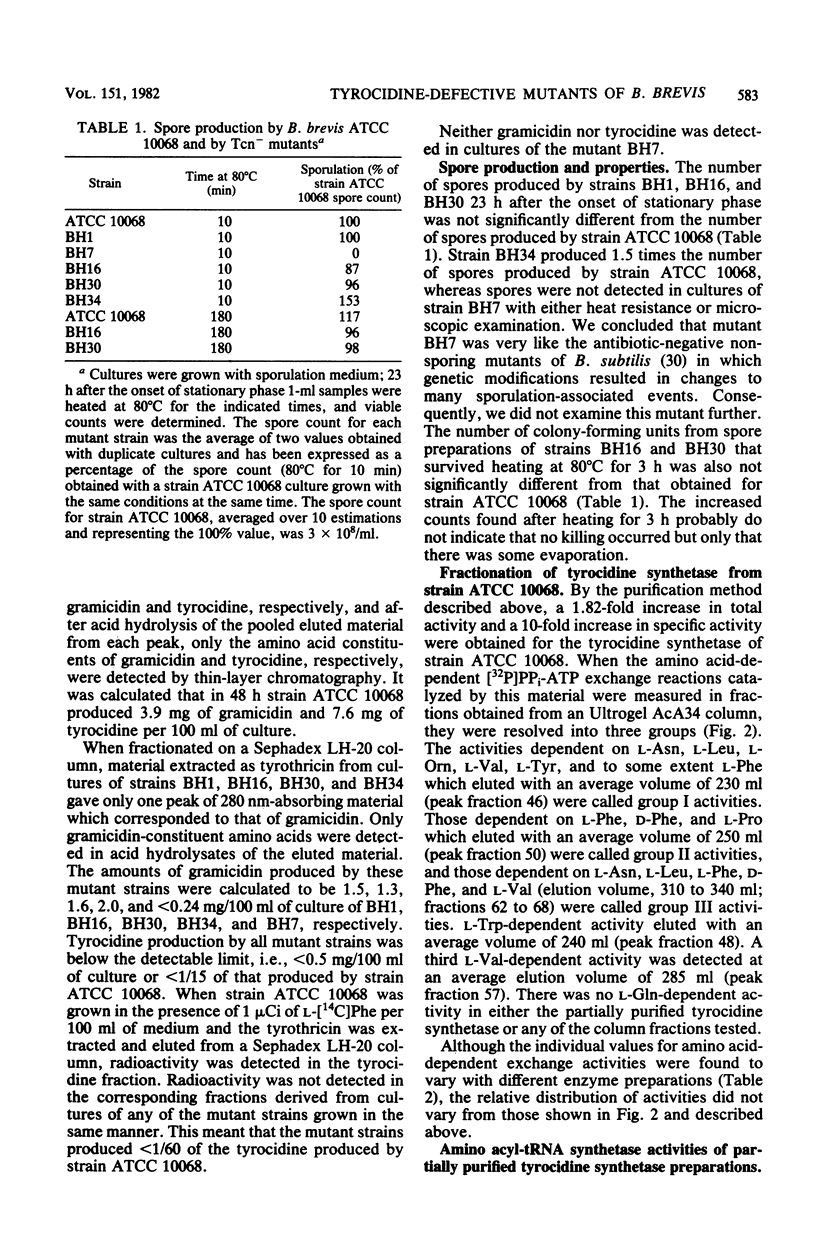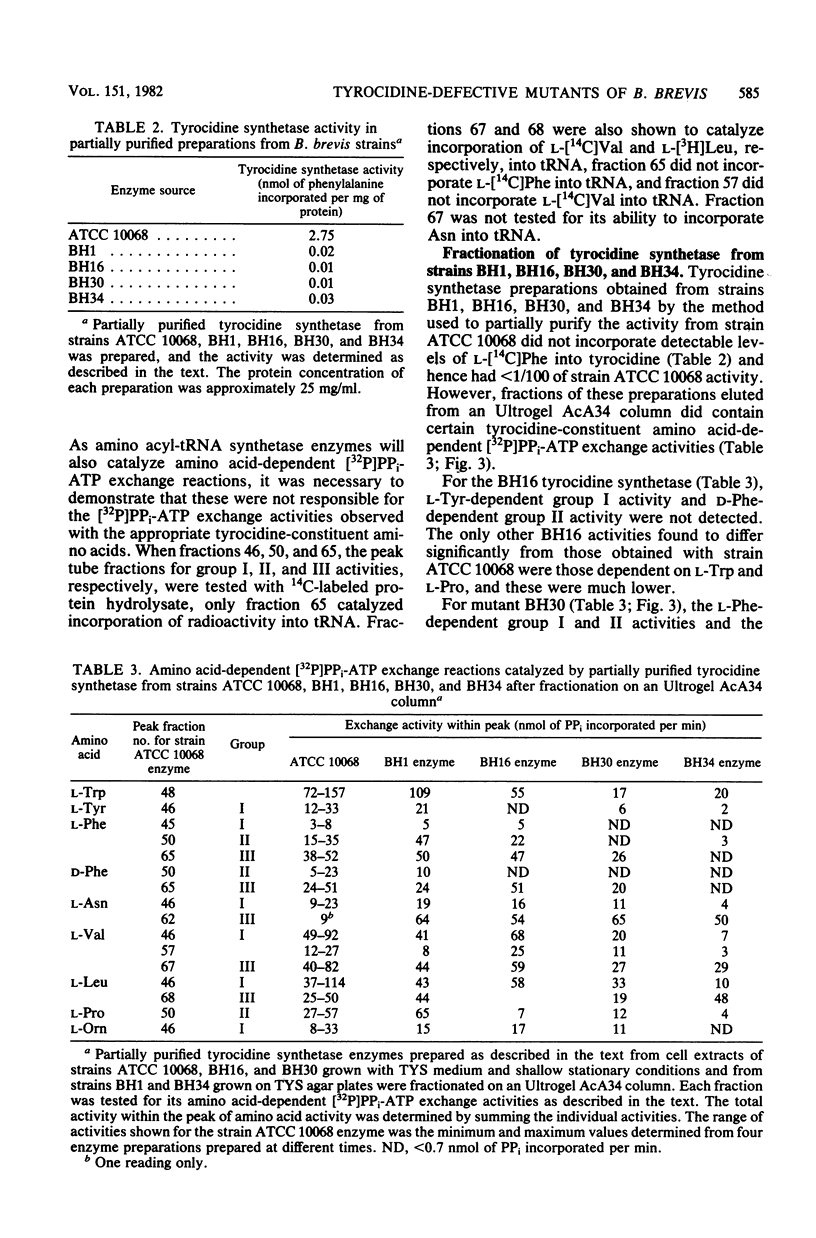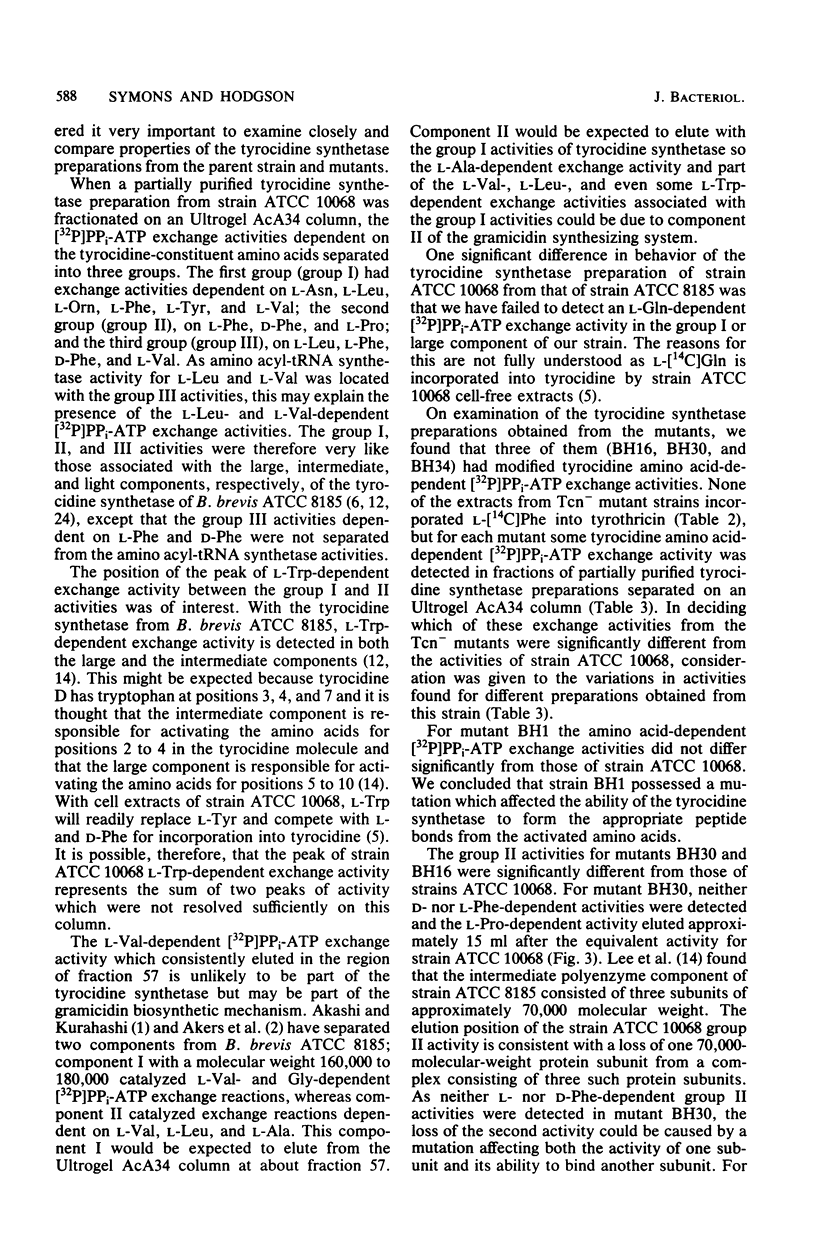Abstract
Mutants of Bacillus brevis ATCC 10068 were isolated which produced less than 1/100 of the amount of tyrocidine produced by the parent strain. These mutants produced spores at the same frequency and which were as resistant to heating at 80 degrees C for up to 3 h as were those produced by the parent strain. A partially purified tyrocidine synthetase from strain ATCC 10068 catalyzed [32P]PPi-ATP exchange reactions dependent on added tyrocidine-constituent amino acids. These activities were separated into three groups (I, II, and III) by fractionation on an Ultrogel AcA34 column. Each group was similar to one of the three components (heavy, intermediate, and light, respectively) found previously for strain ATCC 8185 except that glutamate-dependent activity was not detected in the group I activities and some amino acyl-tRNA synthetase activities were associated with the group III activities. Some of the mutants were shown to have defective tyrocidine synthetase enzymes. Mutant BH30 was defective in two of the group II amino acid-dependent [32P]PPi-ATP exchange reactions, mutant BH16 was defective in one of the group I and one of the group II reactions, and mutant BH34 had alterations to activities in all of the groups. It is unlikely that any of these mutants could synthesise tyrocidine. We conclude that tyrocidine is not involved in either the sporulation process or the resistance of spores of B. brevis ATCC 10068 to heating at 80 degrees C for up to 3 h.
Full text
PDF










Selected References
These references are in PubMed. This may not be the complete list of references from this article.
- Akashi K., Kurahashi K. Formylation of enzyme-bound valine and stepwise elongation of intermediate peptides of gramicidin A by a cell-free enzyme system. Biochem Biophys Res Commun. 1977 Jul 11;77(1):259–267. doi: 10.1016/s0006-291x(77)80191-5. [DOI] [PubMed] [Google Scholar]
- Akers H. A., Lee S. G., Lipmann F. Identification of two enzymes responsible for the synthesis of the initial portion of linear gramicidin. Biochemistry. 1977 Dec 27;16(26):5722–5729. doi: 10.1021/bi00645a012. [DOI] [PubMed] [Google Scholar]
- BERNLOHR R. W., NOVELLI G. D. BACITRACIN BIOSYNTHESIS AND SPORE FORMATION: THE PHYSIOLOGICAL ROLE OF AN ANTIBIOTIC. Arch Biochem Biophys. 1963 Oct;103:94–104. doi: 10.1016/0003-9861(63)90014-6. [DOI] [PubMed] [Google Scholar]
- Bartley I. M., Hodgson B., Walker J. S., Holme G. The use of acid alumina and sephadex LH-20 for the separation and characterization of ethanol-soluble peptides produced by Bacillus brevis. Biochem J. 1972 Apr;127(3):489–502. doi: 10.1042/bj1270489. [DOI] [PMC free article] [PubMed] [Google Scholar]
- Cockburn M. A., Hodgson B., Walker J. S. Properties of an unfractionated tyrocidine synthesizing system from Bacillus brevis ATCC 10068. Microbios. 1973 Nov-Dec;8(31):215–239. [PubMed] [Google Scholar]
- Fujikawa K., Sakamoto Y., Kurahashi K. Biosynthesis of tyrocidine by a cell-free enzyme system of Bacillus brevis ATCC 8185. 3. Further purification of components I and II and their functions in tyrocidine synthesis. J Biochem. 1971 May;69(5):869–879. doi: 10.1093/oxfordjournals.jbchem.a129538. [DOI] [PubMed] [Google Scholar]
- Fullerton P. D., Finch L. R. Use of polyethyleneimine-cellulose thin layers in assay of pyrophosphate-ATP exchange reactions. Anal Biochem. 1969 Jun;29(3):544–547. doi: 10.1016/0003-2697(69)90342-x. [DOI] [PubMed] [Google Scholar]
- Heathcote J. G., Haworth C. An improved technique for the analysis of amino acids and related compounds on thin layers of cellulose. II. The quantitative determination of amino acids in protein hydrolysates. J Chromatogr. 1969 Aug 5;43(1):84–92. doi: 10.1016/s0021-9673(00)99169-6. [DOI] [PubMed] [Google Scholar]
- Hitchcock M. J., Hodgson B., Linforth J. L. Regulation of lysine- and lysine-plus-threonine-inhibitable aspartokinases in Bacillus brevis. J Bacteriol. 1980 May;142(2):424–432. doi: 10.1128/jb.142.2.424-432.1980. [DOI] [PMC free article] [PubMed] [Google Scholar]
- Hodgson B. Possible roles for antibiotics and other biologically active peptides at specific stages during sporulation of Bacillaceae. J Theor Biol. 1971 Jan;30(1):111–119. doi: 10.1016/0022-5193(71)90040-3. [DOI] [PubMed] [Google Scholar]
- Kambe M., Sakamoto Y., Kurahashi K. Biosynthesis of tyrocidine by a cell-free enzyme system of Bacillus brevis ATCC 8185. IV. Further separation of component II into two fractions. J Biochem. 1971 Jun;69(6):1131–1133. doi: 10.1093/oxfordjournals.jbchem.a129567. [DOI] [PubMed] [Google Scholar]
- Lee S. G., Lipmann F. Tyrocidine synthetase system. Methods Enzymol. 1975;43:585–602. doi: 10.1016/0076-6879(75)43121-4. [DOI] [PubMed] [Google Scholar]
- Lee S. G., Roskoski R., Jr, Bauer K., Lipmann F. Purification of the polyenzymes responsible for tyrocidine synthesis and their dissociation into subunits. Biochemistry. 1973 Jan 30;12(3):398–405. doi: 10.1021/bi00727a006. [DOI] [PubMed] [Google Scholar]
- Marahiel M. A., Danders W., Krause M., Kleinkauf H. Biological role of gramicidin S in spore functions. Studies on gramicidin-S-negative mutants of Bacillus brevis ATCC9999. Eur J Biochem. 1979 Aug 15;99(1):49–55. doi: 10.1111/j.1432-1033.1979.tb13229.x. [DOI] [PubMed] [Google Scholar]
- Mukherjee P. K., Paulus H. Biological function of gramicidin: studies on gramicidin-negative mutants. Proc Natl Acad Sci U S A. 1977 Feb;74(2):780–784. doi: 10.1073/pnas.74.2.780. [DOI] [PMC free article] [PubMed] [Google Scholar]
- PENG C. H. L. Butyryl adenylate and its possible function in the fatty acid activating system. Biochim Biophys Acta. 1956 Oct;22(1):42–48. doi: 10.1016/0006-3002(56)90221-9. [DOI] [PubMed] [Google Scholar]
- Randerath K., Randerath E. Ion-exchange thin-layer chromatography. XV. Preparation, properties and applications of paper-like PEI-cellulose sheets. J Chromatogr. 1966 Apr;22(1):110–117. doi: 10.1016/s0021-9673(01)97076-1. [DOI] [PubMed] [Google Scholar]
- Ristow H., Schazschneider B., Bauer K., Kleikauf H. Tyrocidine and the linear gramicidin. Do these peptide antibiotics play an antagonistic regulative role in sporulation? Biochim Biophys Acta. 1975 May 1;390(2):246–252. [PubMed] [Google Scholar]
- Ristow H., Schazschneider B., Kleinkauf H. Effects of the peptide antibiotics tyrocidine and the linear gramicidin on RNA SYNTHESIS AND SPORULATION OF Bacillus brevis. Biochem Biophys Res Commun. 1975 Apr 21;63(4):1085–1092. doi: 10.1016/0006-291x(75)90680-4. [DOI] [PubMed] [Google Scholar]
- Ristow H. The peptide antibiotic gramicidin D. A specific reactivator of tyrocidine-inhibited transcription. Biochim Biophys Acta. 1977 Jul 15;477(2):177–184. doi: 10.1016/0005-2787(77)90233-7. [DOI] [PubMed] [Google Scholar]
- Roskoski R., Jr, Gevers W., Kleinkauf H., Lipmann F. Tyrocidine biosynthesis by three complementary fractions from Bacillus brevis (ATCC 8185). Biochemistry. 1970 Dec 8;9(25):4839–4845. doi: 10.1021/bi00827a002. [DOI] [PubMed] [Google Scholar]
- Sadoff H. L. The antibiotics of Bacillus species: their possible roles in sporulation. Prog Ind Microbiol. 1972;11:1–27. [PubMed] [Google Scholar]
- Sarkar N., Langley D., Paulus H. Biological function of gramicidin: selective inhibition of RNA polymerase. Proc Natl Acad Sci U S A. 1977 Apr;74(4):1478–1482. doi: 10.1073/pnas.74.4.1478. [DOI] [PMC free article] [PubMed] [Google Scholar]
- Sarkar N., Paulus H. Function of peptide antibiotics in sporulation. Nat New Biol. 1972 Oct 25;239(95):228–230. doi: 10.1038/newbio239228a0. [DOI] [PubMed] [Google Scholar]
- Schaeffer P. Sporulation and the production of antibiotics, exoenzymes, and exotonins. Bacteriol Rev. 1969 Mar;33(1):48–71. doi: 10.1128/br.33.1.48-71.1969. [DOI] [PMC free article] [PubMed] [Google Scholar]
- Schazschneider B., Ristow H., Kleinkauf H. Interaction between the antibiotic tyrocidine and DNA in vitro. Nature. 1974 Jun 21;249(459):757–759. doi: 10.1038/249757a0. [DOI] [PubMed] [Google Scholar]


